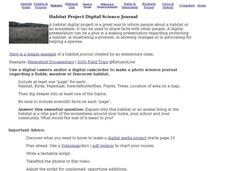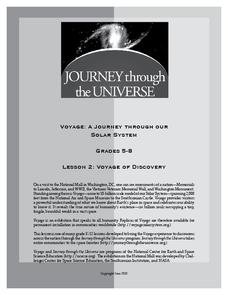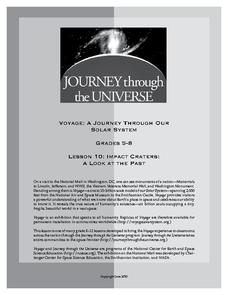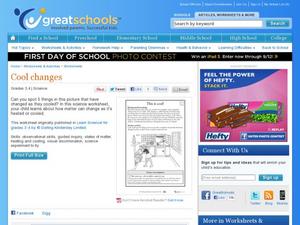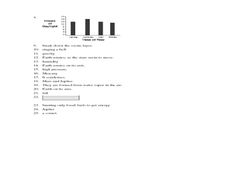Wind Wise Education
What are Wind Shear and Turbulence?
Let's go fly a kite. By flying a kite, class members observe the difference in air flow. The class notices the characteristics of banners tied to the kite string to determine where wind turbulence stops. Adding an anemometer to...
Canadian Space Agency
The Phases of the Moon
What phase is that moon in? Young astronomers complete a lunar cycle diagram and describe each moon phase below.
Class Antics
Leap Year
What is a Leap Year and why do we have it? Find out with this Leap Day/Leap Year response to reading worksheet in which scholars read a short passage and use their new-found knowledge to answer five questions with short...
University of Florida
The Magic School Bus and the Electric Field Trip
Energize a shared reading of the Magic School Bus and the Electric Field Trip with this collection of supplemental materials. Whether your looking for discussion questions, reading comprehension worksheets, or writing prompts,...
Curated OER
Habitat Project Digital Science Journal
In this habitat project digital science journal activity, students use a digital camera or camcorder to create a science journal about a habitat they have studied. This page includes links to helpful web resources for planning and...
Curated OER
What is an Animal?
In this flatworm body plan worksheet, students compare the body plans of several worms. Students answer several questions based upon the given diagrams of a cross section of the different body plans of each worm.
Curated OER
What is Work?
In this work learning exercise, learners will match vocabulary words with definitions: joule, Newton, force, and work. Then students will answer 8 problems based on the equation: work = force x distance.
American Physiological Society
Sticky Adaptations A Lesson on Natural Selection
Now you see it, now you don't! The stick bug exhibits the ability to disappear into a wooded environment. Why does this adaptation manifest in some species, but not in others? Life science high schoolers explore animal adaptations in...
Journey Through the Universe
Voyage of Discovery
Did you know that Pluto is smaller than the United States of America? It is difficult to conceptualize the size of planets and the distance between them, and the lesson addresses those exact issues. After a discussion, pupils create...
Journey Through the Universe
Impact Craters: A Look at the Past
The Galle crater on Mars is also known as the Happy Face crater because of its appearance. First, scholars use pebbles and flour to simulate craters and study their properties. They then apply this knowledge to help decipher the history...
Texas State Energy Conservation Office
Investigation: Gas Laws in Action - Propane
Using helium as an example of propane, physical science middle schoolers experiment with and graph the relationship between temperature and volume in gases. In a whole-class demonstration, they show how molecules behave under different...
Texas State Energy Conservation Office
Investigation: Chemical Models
Science teams make models of four different hydrocarbon compounds that we commonly use for fuel. Then they demonstrate chemical reactions that result when energy is produced. This can be used as an enrichment when your class is studying...
It's About Time
Renewable Energy Sources - Solar and Wind
There has been a huge solar energy spill! Let's go outside to play in it. This lesson includes multiple experiments showcasing solar and wind energies. Scholars build a solar heater and an anemometer before testing the results. The...
Chemistry Teacher
Metals, Nonmetals, and Metalloids Lab
What an exciting way to introduce your blossoming chemists to the world of metals, nonmetals, metalloids, and polymers! Here is a lab activity that is designed to allow pupils the opportunity to visualize the reaction of metals,...
Curated OER
Grow an Alum Crystal
What an exciting lab experiment to conduct with your high school chemistry class! Crystals are formed naturally in the environment. However, allow your blossoming chemists to create their own unique crystals using alum and...
Curated OER
What is a Compound Machine?
In this compound machine worksheet, students review what simple machines are put together to make compound machines. This worksheet has 5 fill in the blank and 2 short answer questions.
Curated OER
What is a Magnet?
In this magnet worksheet, students review what makes up matter, how electromagnets are made, and how compasses work. This worksheet has 6 fill in the blank and 2 short answer questions.
Curated OER
What Lives in Water?
In this early childhood science worksheet set, young scholars study the importance of water, and determine the difference between themselves and water dwellers. They look at adaptations, river life, rainforest life, food chains,...
Curated OER
5th Grade Science
In this science worksheet, 5th graders complete multiple choice questions about flight, astronomers, measurement, temperature, and more. Students complete 25 questions.
Curated OER
This is Cool!
Third and fourth graders who are studying states of matter will enjoy this simple exercise. In it, they look at a picture of a girl in her kitchen, and they must circle five examples of materials that have changed states of matter as...
Curated OER
Fourth Grade Science Concepts Practice
In this grade 4 science instructional activity, 4th graders complete 25 multiple choice questions covering a variety of 4th grade science concepts. An answer key is included.
Curated OER
Is the Moon out tonight?
Learners talk or read about the way the moon travels across the sky. They then look at the picture of where the moon is and draw where it will be in the picture, later in the evening. Note: The worksheet is intended for third or fourth...
Curated OER
What a Nose!
In this science learning exercise, students discover that different bat species have distinctive noses. Students examine 6 pictures of bats and cut and paste the names of the bats by each. No information is given but the names of the...
Curated OER
What Parts of a Plant Do We Eat?
Did you know that tomtoes and cucumbers are actually fruits? Biology or botany beginners read about the function of flowers and fruit and find that some food items commonly called vegetables are, by definition, also fruits! Give learners...
Other popular searches
- What Is Science Important
- What Is Science Worksheets
- Science What Is Science
- What Is Science Fiction
- What Is Science Worhsheets
- What Is a Science Theory
- What Is Science Skills?
- What Is Science Florida
- Science What Is a Rock?




